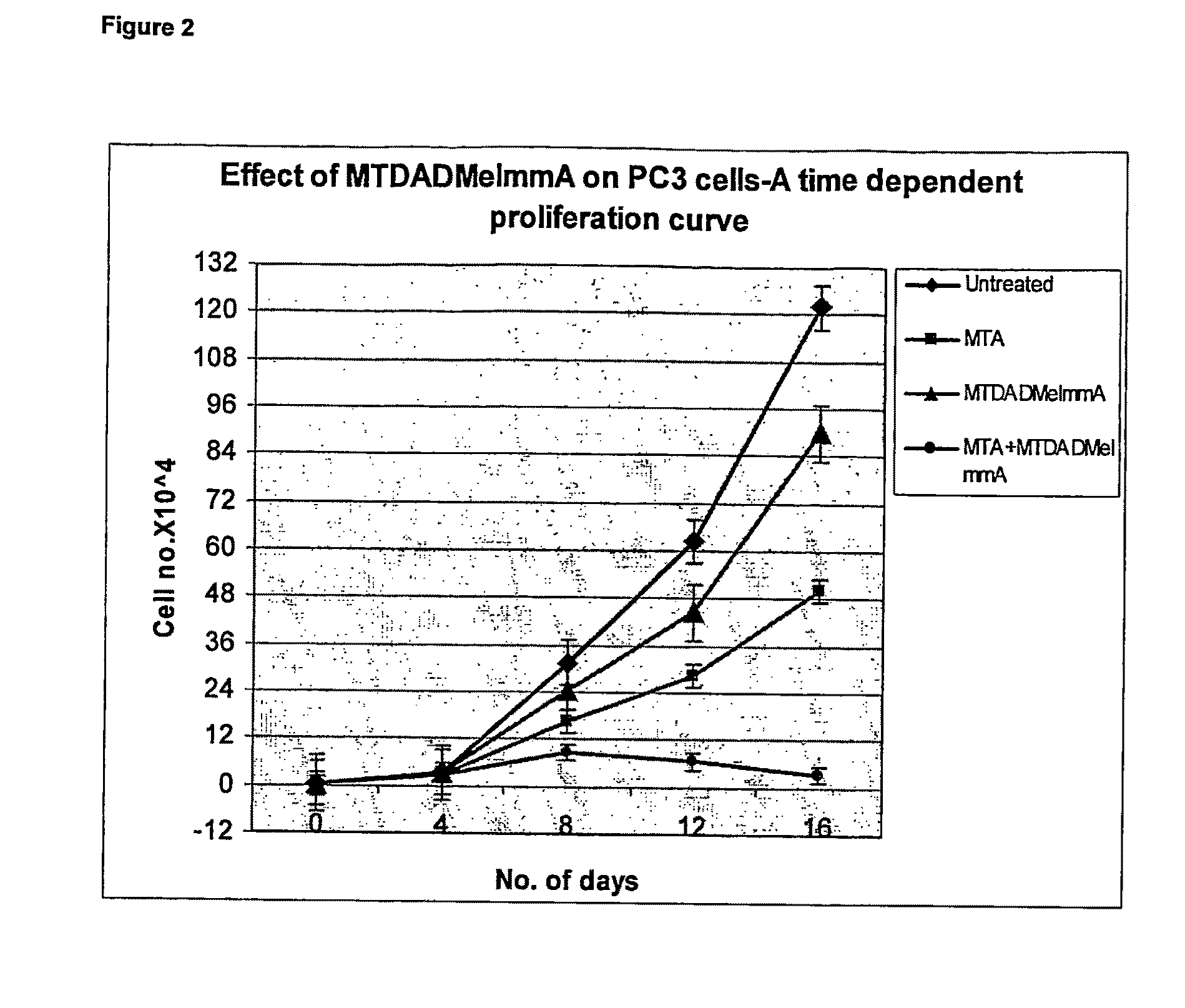Methods of Treating Diseases Using Inhibitors of Nucleoside Phosphorylases and Nucleosidases
a technology of nucleoside phosphorylase and nucleosidases, which is applied in the direction of antibacterial agents, drug compositions, biocides, etc., can solve the problems of limiting the polyamine biosynthesis and the salvage pathway of adenine in the cell, reducing the overall quality of life of a man, and limited treatment options
- Summary
- Abstract
- Description
- Claims
- Application Information
AI Technical Summary
Benefits of technology
Problems solved by technology
Method used
Image
Examples
example 1
Clonogenic Assays (FIGS. 1A and 1B) for Compound (2)
[0188]PC3 cells were grown in equal (1:1) portions of Dulbecco's modified Eagle's medium and F12 containing 10% fetal bovine serum, 10 U / mL penicillin-G and 10 μg / mL streptomycin in monolayers to near confluency at 37° C. Cells were lysed in 50 mM sodium phosphate pH 7.5, 10 mM KCl and 0.5% Triton X-100.
example 2
Effect of Compound 2 and MTA on PC3 Cells (FIG. 2)
[0189]PC3 cells were maintained in MEM Eagle's media supplemented with 10% fetal bovine serum, 100 units / ml penicillin, 100 μg / mL streptomycin, 0.1 mM non essential amino acids and 1 mM sodium pyruvate. Cell survival was evaluated using the WST-1 assay (Kicska G A, Iong Li, Horig H, et al. Proc Natl Acad Sci USA 2001; 98:4593-98). Cells were seeded onto 96 well plates at a density of 104 cells per well, with either no additions, 1 μM compound (2), 20 μM MTA or 1 μM compound (2)+20 μM MTA. IC50 was determined following the manufacturer's protocol (Roche Applied Science, IN). Cells were grown and measured in triplicate or quadruplicate and the error bars show the mean±SD of the multiple samples.
example 3
Effect of Compound 2 and MTA on SCC25 Cells (FIG. 3)
[0190]SCC25 cells were maintained in MEM Eagle's media supplemented with 10% fetal bovine serum, 100 units / ml penicillin, 100 μg / mL streptomycin, 0.1 mM non essential amino acids and 1 mM sodium pyruvate. Cell survival was evaluated using the WST-1 assay (Kicska G A, Iong Li, Horig H, et al. Proc Natl Acad Sci USA 2001; 98:4593-98). Cells were seeded onto 96 well plates at a density of 104 cells per well, with either no additions, 1 μM MT-compound (2), 20 μM MTA or 1 μM compound (2)+20 μM MTA. IC50 was determined following the manufacturer's protocol (Roche Applied Science, IN). Cells were grown and measured in triplicate or quadruplicate and the error bars show the mean±SD of the multiple samples.
PUM
| Property | Measurement | Unit |
|---|---|---|
| Electrical conductance | aaaaa | aaaaa |
| Fraction | aaaaa | aaaaa |
| Fraction | aaaaa | aaaaa |
Abstract
Description
Claims
Application Information
 Login to View More
Login to View More - R&D
- Intellectual Property
- Life Sciences
- Materials
- Tech Scout
- Unparalleled Data Quality
- Higher Quality Content
- 60% Fewer Hallucinations
Browse by: Latest US Patents, China's latest patents, Technical Efficacy Thesaurus, Application Domain, Technology Topic, Popular Technical Reports.
© 2025 PatSnap. All rights reserved.Legal|Privacy policy|Modern Slavery Act Transparency Statement|Sitemap|About US| Contact US: help@patsnap.com



